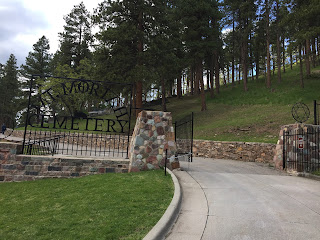My previous post was about Peter Eixenberger's wife, Mary. This time I take a look at another trooper spouse, Carolina Mollar.
Jan Mollar was enlisted on January 15, 1872, in Chicago, Illinois, by Captain Samuel Young. His previous occupation was laborer. He was discharged on January 15, 1877, upon expiration of service, as a corporal of excellent character. He had a sandy complexion, grey eyes, light hair, and was 5’8” tall. He was wounded in the right thigh during the Battle of the Little Big Horn hilltop fight on June 25, 1876. He was later transported to Fort Abraham Lincoln on the steamer Far West.
There are various spellings for Mollar's last name. On pension records he is listed as Jan Moller and elsewhere as John Muller, James Muller, or James Mullen. He was baptized ‘Jens Mathiasen Móller’ but enlisted under the name of Jan Moller. [Peter Russell email of March 21, 2009]. His gravestone at Mount Moriah lists his last name as 'Mollar', so that is what I'm using here.
MARRIED.
MOLLER - ANDERSON - Sunday, October 4, 1891,
Justice Crawford officiating. John Moller to Carolina Anderson.
The wedding had a spice of romance in it. In childhood the bride and groom had been playmates in old Denmark. Years ago the groom came to this country, drifting to the Hills, located a ranch west of this city, prospered, and finally wrote for his boyhood’s sweetheart. Saturday she arrived in Deadwood, and Sunday the nuptial knot was tied. The groom is highly spoken of by those here who have known him for years. The bride, about 35 years of age (the groom is about 42) is described as a bright, comely woman, a fit helpmeet for her industrious husband. [Spearfish Weekly Register; October 10, 1891]
According to her headstone, Carolina was born in Sweden on June 18, 1849. [Researcher Peter Russell provides a birthdate of June 11, 1849] In 1898, the Mollars headed to Denmark, where they lived until 1903. In March 1903, they emigrated to the United States and eventually ended up living with Carolina's son, William, in Deadwood at 63 Stewart Street.
.JPG) |
| Former Mollar home, 63 Stewart Street, Deadwood, South Dakota. |
Carolina Mollar died in her son's home on Wednesday, January 11, 1928.
 |
| Daily Deadwood Pioneer-Times; January 12, 1928 |
Carolina's funeral was held in Deadwood, South Dakota, on Saturday, January 14. She was buried in Mount Moriah Cemetery, Section 2 Plot 200.
 |
Lead Daily Call; January 13, 1928
|
Jan Mollar died six weeks later and is buried next to his wife.
 |
| Entrance to Mount Moriah Cemetery, Deadwood, South Dakota |
.JPG) |
| Jan and Carolina Mollar, Mount Moriah Cemetery, Deadwood, South Dakota |
.JPG) |
| Jan and Carolina Mollar, Mount Moriah Cemetery, Deadwood, South Dakota |
It is very easy to visit the graves of Jan and Carolina. When you enter the front gates at Mount Moriah, follow the walking path and you will see a set of elevated graves to your right. The Mollar headstone is among these and can be easily seen from the walking path. For technology lovers, the GPS coordinates of the grave are 44.375392 -103.724389.
Much of the biographical information for Carolina is from the article, The Third Dane Who Survived the Little Big Horn Fight by researcher Peter Russell that appeared in the Frontier Army of Dakota Post-Dispatch in the Spring 2019 issue.






.JPG)



.JPG)
.JPG)
.jpg)





